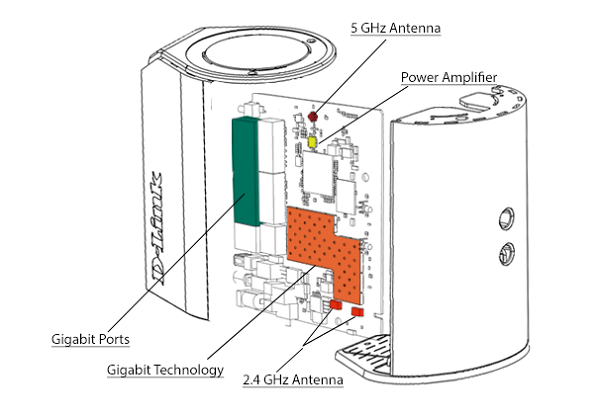Router SoC 101
Do you ever wonder what goes on inside a router? In this article, we take a close look at the SoCs inside of them, which help us manage and maintain our connected lives.
Introduction

What, exactly, does a router do? And how does it do it? Although the answer to the first question can be relatively simple—a router routes data packets along networks—all of the complexity lies in "how."
Routers come in many shapes and sizes: a room full of rack-mounted, dedicated systems for enterprise clouds; off-the-shelf commercial boxes from manufacturers like Linksys or D-Link; and DIY solutions the size of a deck of cards, built on hobbyist platforms like Raspberry Pi.
Leaving aside the overall meta architecture of packet exchange, the core hardware of a modern commercial router (aimed at the small business and home networking markets) distinguishes it from enterprise or application-specific solutions. Specifically, such a router emphasizes convenience. Single devices act as a DSL modem, router, wireless access point, media server and connection to the smart kitchen sink. Also, the processor and connectivity are geared toward a completely different profile (high-bandwidth use for gaming and streaming, along with simultaneous connections from multiple devices, including smartphones and fridges) than enterprise-oriented platforms.
This article focuses on the hardware that runs modern consumer routers. And in today's routers, SoC (system on a chip) solutions are universal—all of the hardware we cover comes in the form of integrated SoCs. These multi-function systems comprise a variety of configurations with different capabilities, making it more difficult to dig into their respective architectures; but they simplify the router design process. There are far fewer devices to consider when a single board comes with everything built onto it.
That doesn't mean completely integrated systems are the only off-the-shelf setups worth considering, though. Even in the world of SoCs, factors like cost, power consumption and OEM requirements do create a world of chimeric SoC solutions, with multiple high-power radios or transceivers pressed in to service a higher-level processor/memory board, or an xDSL modem connected to one of the ports of a more general-purpose processor. Solutions with discrete RAM or flash memory modules and transceivers with separate radio chips do exist, but they are few and far between. And so we focus on the two classes of SoCs that are most often seen in the wild: processor/all-in-one chips and transceivers.

A Note On Software/Firmware
Commercial routers overwhelmingly favor Linux as an operating system, and often employ a customized version. A lightweight Web server is almost always installed as well for user-controlled device configuration.
Another OS, VxWorks, is used only in enterprise-class systems, but it merits a mention if only because it is used on the Mars Reconnaissance Orbiter, and I would buy a commercial router running VxWorks regardless of how unwieldy the final system becomes.
Get Tom's Hardware's best news and in-depth reviews, straight to your inbox.
Finally, an open, Linux-based standard, OpenWrt, is being embraced by more OEMs, even though it was previously mostly used by prosumer hobbyists.
MORE: Wireless Routers 101
MORE: All Networking ContentMORE: Networking in the Forums
-
bwhiten Uhhhh...Those first pictures are not "schematics". They are CAD renderings of the box and main board at best, but definitely not schematics.Reply -
EdJulio ReplyUhhhh...Those first pictures are not "schematics". They are CAD renderings of the box and main board at best, but definitely not schematics.
Thanks, bwhiten. Updated the caption...
-
bit_user Nice article!Reply
Small, irrelevant fact: MIPS was once owned by SGI and used in their servers and workstations. They even used a MIPS CPU in the N64, which they designed for Nintendo. In fact, that was largely the outcome of a previous (if not the first) wave of VR hype. But, I digress...
Also, most people consider ARM to be RISC. Or, at least as much as anything is, these days. Indeed, the name once stood for Advanced RISC Machines.
But I didn't know what MIPS originally stood for, so thanks for that. I wonder whether or how long that remained true of their architectures. -
EdJulio Reply17548227 said:Nice article!
Small, irrelevant fact: MIPS was once owned by SGI and used in their servers and workstations. They even used a MIPS CPU in the N64, which they designed for Nintendo. In fact, that was largely the outcome of a previous (if not the first) wave of VR hype. But, I digress...
Also, most people consider ARM to be RISC. Or, at least as much as anything is, these days.
Thanks! I'll share this with Gene! Cheers!!! -
bit_user Reply
Thanks, but I did say it was irrelevant. It really has no bearing on the routers using these chips.17548234 said:Thanks! I'll share this with Gene! Cheers!!! -
GeneFabron ReplyNice article, is there any more on how tech works? Like cpu and gpu?
Hi QuangT, we have a Wireless Routers 101 http://www.tomshardware.com/reviews/wireless-routers-101,4456.html and a PSUs 101 http://www.tomshardware.com/reviews/power-supplies-101,4193.html article, and there will be more coming soon! -
Gabriel_1965 Question: I've seen a router with 72 cores would that be made to be a 72 core pic and I could use the cores for multi ore computing?Reply